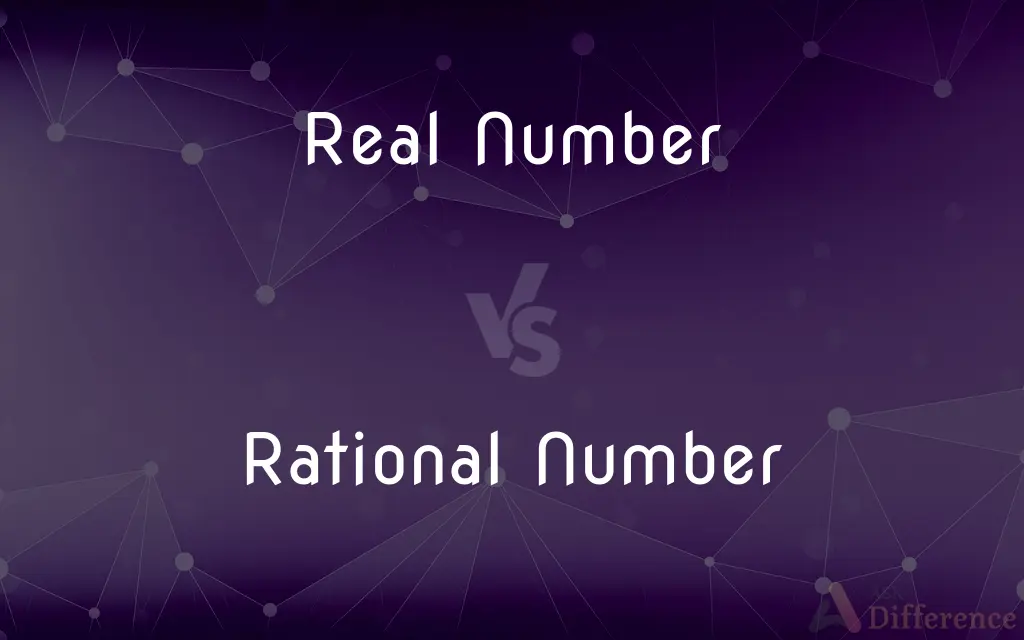Real Number vs. Rational Number — What's the Difference?
By Tayyaba Rehman — Published on December 5, 2023
Real Numbers encompass all numbers on the number line; Rational Numbers are numbers expressible as a fraction.

Difference Between Real Number and Rational Number
Table of Contents
ADVERTISEMENT
Key Differences
Real Numbers refer to all the numbers that can be plotted on a number line. This includes not just whole numbers, but fractions, decimals, and even irrational numbers. Rational Numbers, on the other hand, are a subset of Real Numbers. They are numbers that can be written as a fraction, where both the numerator and the denominator are integers, and the denominator isn't zero. While all Rational Numbers are Real Numbers, not all Real Numbers are Rational.
For instance, the square root of 2 is a Real Number, but it isn't rational because it can't be exactly expressed as a fraction.
Conversely, the number ½ is both a Real Number and a Rational Number. It's essential to note that the set of Rational Numbers is dense on the number line, meaning between any two Rational Numbers, there's another Rational Number. However, there are also many Real Numbers that aren't Rational, filling in the gaps.
Comparison Chart
Definition
Numbers that can be plotted on a number line.
Numbers that can be expressed as a fraction.
Includes
Rational and Irrational Numbers
Integers, fractions, terminating/repeating decimals.
ADVERTISEMENT
Example
√2, π
1/2, 3
Density
Both dense and continuous on the number line.
Dense but not continuous on the number line.
Sub-set relationship
Encompasses Rational Numbers.
Is a subset of Real Numbers.
Compare with Definitions
Real Number
Real Numbers can be either positive, negative, or zero.
-7 is a negative Real Number.
Rational Number
Rational Numbers don't include irrational values.
2/3 is a Rational Number, but √2 isn't.
Real Number
Real Numbers include both rational and irrational numbers.
The value of √2 is an example of a Real Number that's irrational.
Rational Number
Rational Numbers can be either terminating or repeating decimals.
0.75 is a terminating decimal and a Rational Number.
Real Number
Real Numbers are values that represent a quantity on a number line.
3.14 is a Real Number used to approximate π.
Rational Number
Rational Numbers can be expressed as a fraction of two integers.
5/2 is a Rational Number.
Real Number
Real Numbers encompass all continuous values.
Between 0 and 1, there's an infinite number of Real Numbers.
Rational Number
Rational Numbers include all integers.
The number 4 is an integer and also a Rational Number.
Real Number
Real Numbers can be finite or infinite decimals.
0.333... is a Real Number with a repeating decimal.
Rational Number
Rational Numbers have a numerator and a denominator.
In the Rational Number 3/4, 3 is the numerator and 4 is the denominator.
Common Curiosities
What is a Real Number?
A Real Number is any number that can be plotted on a number line, including both rational and irrational numbers.
Are all Rational Numbers also Real Numbers?
Yes, all Rational Numbers are a subset of Real Numbers.
What's an example of a Rational Number?
An example of a Rational Number is 7/3.
What makes a number irrational?
A number is irrational if it cannot be expressed as a fraction of two integers.
Do all Real Numbers have exact decimal expansions?
No, some Real Numbers, like π or √2, don't have exact decimal expansions.
Between any two Real Numbers, is there another Real Number?
Yes, there are infinitely many Real Numbers between any two given Real Numbers.
Can the square root of a non-perfect square be a Rational Number?
No, the square root of a non-perfect square, like √2, is irrational.
Can a Real Number be irrational?
Yes, Real Numbers can be either rational or irrational.
How are Real Numbers different from Complex Numbers?
Real Numbers can be plotted on a number line, whereas Complex Numbers include imaginary parts and are plotted on a complex plane.
Is zero considered a Rational Number?
Yes, zero is a Rational Number because it can be expressed as 0/1.
What defines a Rational Number?
A Rational Number is a number that can be expressed as a fraction where both numerator and denominator are integers, and the denominator isn't zero.
Can Rational Numbers be negative?
Yes, Rational Numbers can be positive, negative, or zero.
Are all integers Rational Numbers?
Yes, all integers are Rational Numbers because they can be expressed as a fraction with a denominator of 1.
Is 0.333... a Rational Number?
Yes, 0.333... (repeating decimal) is equivalent to 1/3, which is a Rational Number.
Why is π considered a Real but not a Rational Number?
π is a Real Number because it can be plotted on a number line, but it's not Rational as it can't be precisely expressed as a fraction of two integers.
Share Your Discovery

Previous Comparison
Binary Acids vs. Ternary Acids
Next Comparison
Steins Gate 0 vs. Steins GateAuthor Spotlight
Written by
Tayyaba RehmanTayyaba Rehman is a distinguished writer, currently serving as a primary contributor to askdifference.com. As a researcher in semantics and etymology, Tayyaba's passion for the complexity of languages and their distinctions has found a perfect home on the platform. Tayyaba delves into the intricacies of language, distinguishing between commonly confused words and phrases, thereby providing clarity for readers worldwide.











































